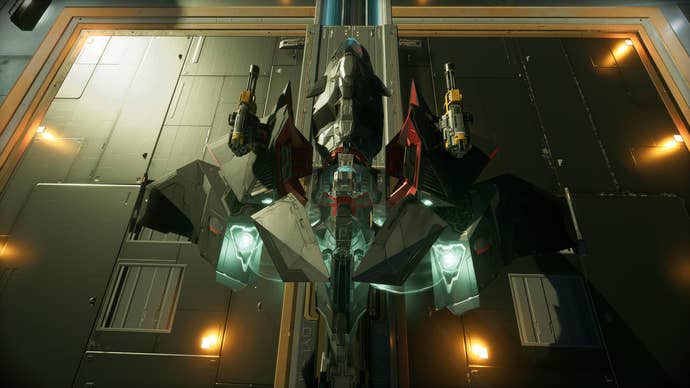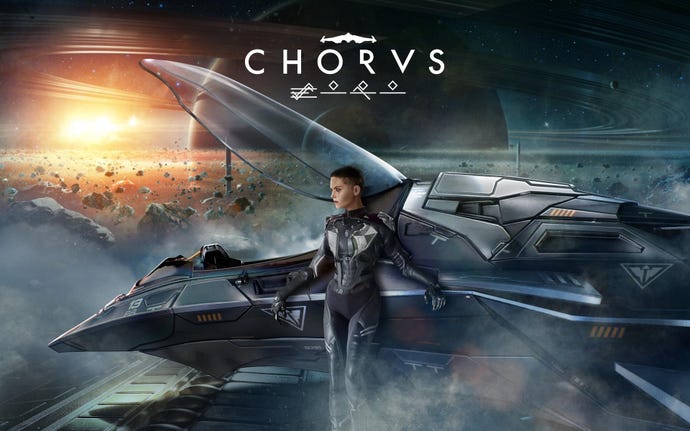Chorus review-in-progress – what a delightful end-of-year-surprise
Chorus constantly punches above its weight.
Fishlabs, the German developer behind space action game Galaxy on Fire, returns with what will prove to be its magnum opus: Chorus. From the first time the team’s new space shooter was revealed at an Xbox show, the presentation was immediately attention-grabbing. Questionable title stylising aside, the trailer made me anxious to play it.
Chorus launches today, and I have been playing it for a few days now. Though I am not ready to assign a score just yet, I am here to tell you about the hell of a good time I’ve been having with it.
Chorus is a fairly straightforward space shooter. You’re in a ship, you go around solving problems mostly using the weapons mounted on your ship, or in this case, manifesting from what looks to be programmable matter.
Space games don’t always strike a good balance between tight controls and how easy it is to pull off some impressive maneuvers. This is made even more complicated when you consider which control method the developer had in mind when designing the game. Some play like a dream with a controller, but absolutely break when you use a mouse. Others are PC-first, and so designed around the precision of a mouse.
Chorus is among a rare breed of space shooters that feels good to play on both. I chose a mouse for my time with it, because that’s what I am more comfortable with. You can set separate sensitivities for inner and outer circle movements, and it’s generally smart enough to slightly aid you when you try to keep up with fast-movers.
The game leans a little harder into the arcade side of things. There are no buttons for ascending/descending, for instance, which can make certain situations awkward as you try to control elevation and move your aim towards a target simultaneously. Nevertheless, it’s a limitation that doesn’t get in the way of most of the action.

The first thing you’ll notice (outside of flying mechanics), is Chorus’ sentient ship: Forsaken. The ship is as much a partner, a companion, as it is a cool design that carries your guns.
Nara, the game’s protagonist, is constantly in conversation with Forsaken. They discuss the larger story beats, complement each other’s moves during firefights, and call out dangers you might miss in the heat of combat. It’s one of the game’s best qualities. The pair’s different personalities often make these chats interesting rather than predictable, revealing more about each of them throughout.
Chorus’ most interesting mechanic is Rites, essentially abilities at Nara’s disposal. As a former member of a techno space cult, she was taught to heighten her senses and see beyond the physical world.
These manifest in six powers that are all incredibly useful and incredibly fun to use in equal measure. The game starts you out with a scan that can highlight collectibles in the immediate vicinity or send out a wider pulse that marks nearby objectives on the map. The latter actually comes in very handy in most areas, as the game’s map seems like an incomplete feature abandoned during development. It’s often a foggy mess of clouds where objectives hide, and its layout is never clear or distinctive enough to be useful on its own.
In general, Chorus does a poor job of laying out and tracking objectives. It’s common to mark a secondary mission and have the game automatically switch to a main mission nearby once you get close enough. I’ve had this happen enough times with a particular side mission that I just abandoned it completely.
3D markers tend to quickly disappear and require constant pulses to get them back on your HUD. It’s a bit of a chore, especially with how large and dense these sectors can be. The objectives themselves could also use a bit more clarification. Sometimes you’ll arrive at the intended spot without any idea what you’re supposed to do next. The description rarely helps solve this puzzle, and you’ll be left to your devices to figure out what it wants or give up and move on. The quest menu, too, is a mess. It’s a bit of a challenge to figure out what you’re currently tracking, and which quests spawned out of others.
I love the sense of discovery in Chorus, particularly as its different environments are home to a decent range of side activities, and in how layered certain areas get. You’re often rewarded with pick-ups and lore the more off the beaten path you travel. But, it would help to get nudged in the right direction occasionally.

The pace of how Rites are introduced isn’t always apparent. Sometimes it feels like you’ve been playing for hours without discovering a new one, even when it seems like you’re reaching the end of a story thread. Making up for Chorus’ sporadic structure are the Rites themselves, which are among the highlights of my time with the game.
The second Rite lets you drift a-la Battlestar Galactica, using your ship’s momentum to pull off some sharp turns, incredibly useful when dealing with large ships and exhilarating in dogfights. Other Rites offer unique advantages in combat, such as one that positions you behind an enemy.
As you get more of these powers, Chorus also introduces new enemy types that really test your mastery of all Rites. Another highlight are the massive battleships, each require a certain process to be taken down. For some, you need to destroy shield generators, then maneuver your ship inside to target the core. Others have even more stages that could take several minutes to pull off.
These moments are always a thrill because they demand a lot from you while offering agency in how you approach them.
Later into the game, different types of ships begin to show up together, often in formations where lighter classes run interference as heavier cruisers barrage an objective you’re supposed to protect. Chorus will also occasionally mix in mine-laying drones and other unique types that each need to be dealt with in a different way. Some of the late-game battles will have you constantly switching between Rites as you try to stay alive.
Rites also serve a narrative purpose. The more of Nara’s dark past she’s able to reconcile with, the more of them will unlock. This gradually happens over the course of the story. The cast generally does a good job portraying this struggle, even if some of those scenes can be a little overdramatic without delving into the core of her trauma. Forsaken, too, gets its own arcar, one my favourites in the entire story.
Progression is fairly linear in Chorus. Beyond these story-mandated powers, you won’t be earning much else, or coming across any in the world. You can upgrade your ship using components found in the world and given as quest rewards, but you’ll have seen it all a few hours into the game – the rest are just better versions. Weapons are the same way; the three types you start with are all you’re going to get – the rest are just different variations of them.
It’s not so much a knock against the game, but it does hinder variety, particularly since the combat is so satisfying, you’d want to experiment with wacky sci-fi weapons.
I need to play more to see where the story ends up going, but I feel confident in recommending Chorus based on its mechanics and the amount of content you have access to. It also runs incredibly well on PC, to the point I’d be okay with a little bit of a worse performance if I could get sharper textures.
Version tested: PC. Code provided by publisher. Also available on PS4, PS5, Xbox One, Xbox Series X/S, and Stadia.


